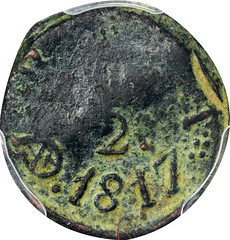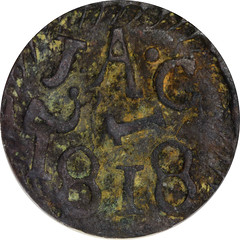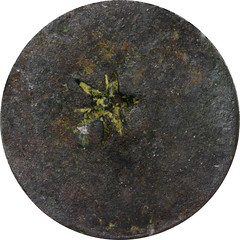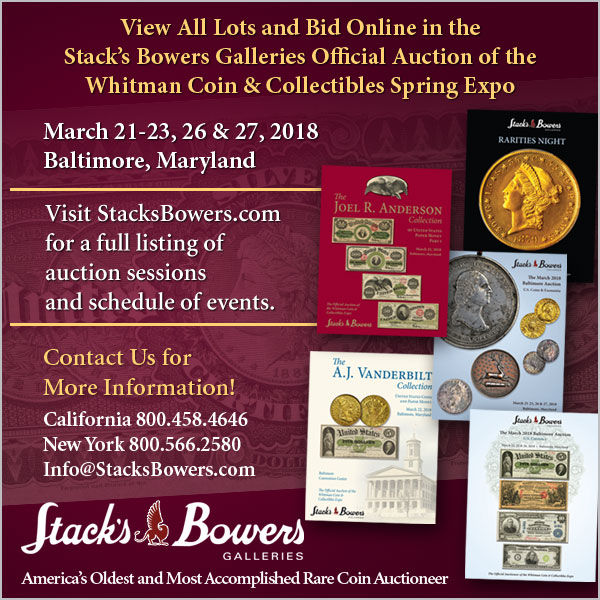
PREV ARTICLE
NEXT ARTICLE
FULL ISSUE
PREV FULL ISSUE
TEXAS JOLAS OFFERED IN KAGIN'S MARCH 2018 SALEWith commentary by researcher James Bevill, a press release from Kagin's describes in great historical detail the two rare Texas jolas being offered in the firm's sale at
the ANA's National Money Show in Irving, Texas this week. Fabulous coins. -Editor
  1817 Jola Kagin’s auction to feature 1817 and 1818 New Spain (Texas) jolas – the first ever date set offered at their ANA National National Money Show auction at the Irving, TX Convention Center. The ANA National Money Show in Irving, Texas, March 8-10 will have a double dose of Texas rarity up for sale in Kagin’s auction. Lots 1027 and 1028 will feature two jolas, small copper coins struck for regional use in Spanish Texas. They are dated 1817 and 1818 respectively. In the interior of Texas there was a bustle of commerce and daily activity around the early Spanish missions of the early 1800s. The areas of San Antonio, Goliad, and Nacogdoches had flourished and became the most successful of the Spanish settlements. Only four years after the brutal suppression of an armed uprising in 1813, an uneasy peace had been established. The Presidio of San Antonio de Béxar was once again thriving, but still boasted a large number of Spanish troops among its population. It was in this relatively quiet period during the struggle for Mexican Independence from Spain that an obscure but significant event in the history of Spanish Texas occurred. An impromptu minting of small copper coins in San Antonio de Béxar would mark the first appearance of the five-pointed lone star—the symbol for Texas. Once the coins were minted, a public notice was posted, “Our neighbor Don Manuel Barrera having petitioned to this government the milling of five hundred pesos in total containing his name and surname; this government has accepted this individual’s solicitation to mill five hundred pesos in total, with a value of half a real for each for use in purchases and sales and should circulate in the commerce of this city and no one should decline to accept them. I sign this in San Fernando de Bexar on the 29th day of the month of March in 1817 to advise the public.”   1818 Jola The 1818 New Spain (Texas) jolas have been well known in the numismatic world since the discovery of some 60 or so jolas along the bank of the San Antonio River in 1959. Although the 1817 decree gave the authorization to mint the jolas, the 1817 coins were an elusive rarity that had only existed by paper decree, but which finally came to light for the first time in my 2009 book, The Paper Republic: The Struggle for Money, Credit, and Independence in the Republic of Texas. There were, in fact, 1817 dated jolas which bore the initials “MB” on the obverse, the denomination ½ (real), with a horizontal fraction, the numerator “1” on the right side, and an incuse five- pointed lone star on the reverse. One of the five discovery pieces is now the plate specimen on page 79 in the “The Official Red Book”, or the Guide Book of United States Coins 2015 by R. S. Yeoman, edited by Kenneth Bressett. But numismatics can be a dynamic and ever changing field as new information and new discoveries come to light. In 2010, I became acquainted with a Dallas collector, who showed me three small copper coins, dated 1817, that he and a friend found while metal detecting in the mid-1960s. They were dug up at the site of Mission San Bernardo, adjacent to San Juan Bautista at the present day town of Guerrero, Mexico near Eagle Pass. Spanish explorers used these early missions as a staging area for expeditions into Texas. This places these coins squarely in the trade route from San Antonio de Bexar to the interior of Mexico. One of these coins had a three-digit date “817”, the other two had a four-digit date “1817.” One of those later specimens is the same as is being offered in the Kagin’s auction. This 1817 (New Spain) Texas jola is offered as lot # 1027 in the Kagin’s sale. It is certified and graded as F-12 by PCGS. The catalogue states that it “was the first 1817 jola to be certified by any major grading service.” This specimen is earthy in appearance with the patina-like surfaces often found on ancient bronze coins. Areas of deep rusty brown and pale sea-green patination share the obverse. The ½ denomination is vertical, with the denominator, “2”, boldly evident, as is AD 1817, those areas the boldest of all the design elements. The letter “R” appears in the obverse legend but the remainder of the letters are obscured by heavy wear and/or a weak strike, save for an “I”. The reverse bears a multi-pointed motif on the reverse which resembles a flower rather than the distinct, incuse five pointed lone star found on the reverse of the 1818 specimen. Undoubtedly this ½ real piece is also an 1817 jola, as it was a small copper coin used to make change. All known specimens were struck from crudely cast dies. The low survival rate of the 1817 jolas can be explained in part by their withdrawal from circulation on the order of local authorities on December 6, 1818. A posted order recalling the Barrera coins translates in part: “The circulation of the previously minted coins by D[on] Manuel Barrera should cease today. And with the effect that whoever has the jolas minted by Barrera should not lose them and present them to D. Jose Antonio Lagarza [sic] within 12 days. He will receive them and give them the same quantity of the newly minted coins. The 1818 (New Spain) Texas jola is offered as lot # 1028 in the Kagin’s sale. It is certified and graded as VF-35 by PCGS. This small planchet variety has deep olive-brown surfaces that are somewhat crusty in appearance, a good sign that this specimen has never been tampered with, never harshly cleaned, and has a pleasingly original appearance. Obverse with J.A.G. at the top, 1818 at the bottom, ½ on its side in the center, with the numerator “1” on the right side, large spiked dentils nearly encircle the periphery. The otherwise unadorned reverse is impressed with a hand-entered five-pointed lone star at center. It represents the symbol for Texas, the Spanish territory in which it was struck for regional use. This specimen presents a rare opportunity to acquire an 1818 jola with the lone star reverse in an altogether excellent state of preservation. The Kagin’s sale is also highly unusual in that there are offered both an 1817 and 1818 dated New Spain (Texas) jolas for sale. It’s not a frequent occurrence to find a single jola in a public auction sale, and now resourceful bidders have the opportunity to take home two prizes, perhaps even as a pair to one tenacious bidder if he or she plans their strategy accordingly. A mere nine years after the opening salvos of disclosure for these rare Texas half-real pieces, came to light, the fame of this rarity has spread near and far. The two coins being offered present a collecting opportunity as big as Texas. James P. Bevill is the author of The Paper Republic, The Struggle for Money, Credit and Independence in the Republic of Texas. Author’s note: (Bevilll’s first edition contained a translation error of the mintage as 1,500 pesos. Although this error was corrected to 500 pesos in the 2011 Numismatist article Lone Stars Rising, and in the second edition of The Paper Republic,2012, the mistake was quoted and in the 2012 Stacks Bowers auction catalogue, where the present 1817 jola being offered was listed as Lot# 11155.  Wayne Homren, Editor The Numismatic Bibliomania Society is a non-profit organization promoting numismatic literature. See our web site at coinbooks.org. To submit items for publication in The E-Sylum, write to the Editor at this address: whomren@gmail.com To subscribe go to: https://my.binhost.com/lists/listinfo/esylum All Rights Reserved. NBS Home Page Contact the NBS webmaster 
|